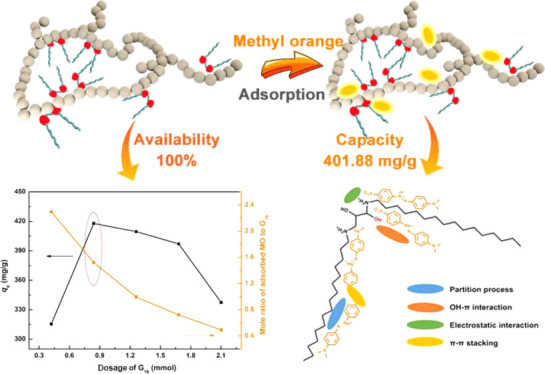- Record: found
- Abstract: found
- Article: found
Effective Adsorption of Methyl Orange on Organo-Silica Nanoparticles Functionalized by a Multi-Hydroxyl-Containing Gemini Surfactant: A Joint Experimental and Theoretical Study

Read this article at
Abstract

A novel multi-hydroxyl-containing gemini surfactant (G 16) is first designed for modifying silica precursors (SiNPs), with the purpose of fabricating organic adsorbents targeted at methyl orange (MO). The purity of G 16 and structural character of the resultant G 16-SiNPs are unveiled through Fourier transform infrared spectroscopy, X-ray diffraction, thermogravimetry-derivative thermogravimetry, scanning electron microscopy, and surface analysis (BET). Compared with SiNPs, G 16-SiNPs exhibit enhanced hydrophobicity, enlarged interlayer spacing, and increased thermal weight losses with the modifier availability reaching as high as 100%. Enhanced MO adsorption is obtained from the higher adsorption capacity of G 16-SiNPs (401.88 mg/g) than SiNPs (64.72 mg/g), which is more effective than most of the existing silica-based adsorbents. Pseudo-second-order and Langmuir models conform to all adsorption processes, indicating that the adsorption mainly relies on the availability of adsorption sites and characterized by a homogeneous adsorption form. By combining the experimental study and theoretical calculation methods, it can be demonstrated that the as-synthesized adsorbent G 16-SiNPs own multi-active sites that contribute to multi-adsorption mechanisms. The partition process, electrostatic interactions, and OH−π interactions are all responsible for the adsorption performance of G 16-SiNPs. This study throws light on the exploration of the superb MO adsorbent in aspects of not only the novel structured modifier and precursor but also theoretical analysis for gaining insights into the adsorption mechanism.
Related collections
Most cited references49
- Record: found
- Abstract: not found
- Article: not found
Recent advances for dyes removal using novel adsorbents: A review
- Record: found
- Abstract: not found
- Article: not found
Dyes adsorption using clay and modified clay: A review
- Record: found
- Abstract: not found
- Article: not found